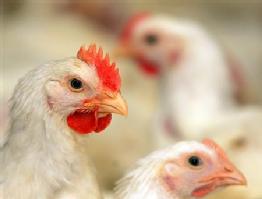Avian Influenza
Two primary modelling studies have examined the dynamics of H5N1 in poultry. Both of these indicate that with care avain influenza can be controlled in the UK poultry industry, although the standard epidemiological tenets of prompt detection and rapid control are neccessary.
 Vaccination of Poultry on Farms
Vaccination of Poultry on Farms
Simulations have shown that vaccination of poultry (which is never 100% effective) can lead to a much slower epidemic within flocks, which could in principle go undetected for many days or weeks. In unvaccinated flocks the epidemic is rapid and is associated with high mortality rates; therefore there is little chance of it going undetected or of it being spread to other farms. In contrast a low epidemic in a partially immune flock could lead to a far greater chance of spreading infection to other farms.
Although this is a stark warning message of the potential problems with mass vaccination, there are two mitigating factors: i) sential birds which are deliberately left unvaccinated (susceptible) can allow us to detect (even slow) epidemics in vaccinated flocks. ii) the level of vaccination required to give rise to significant but undetected epidemics is a relatively narrow parameter regime which depends on flock-size -- it is therefore highly unlikey that more than a few farms would ever suffer this effect.
Control of H5N1 in the UK
The vast majority of poultry on UK farms move through a highly defined pyramidal hierachy. This means that the movement of birds can only transmit infection down through the pyramid, limiting the spread of the disease. Individual models of the UK broiler and layer industries, based on network and spatial FMD models, has shown that, unless there are extreme amounts of unregulated and random transmission events occur, then any outbreak is likely to be rapidly controlled by current contingency plans.
Publications
NJ Savill, SG St Rose, MJ Keeling, MEJ Woolhouse (2006) Silent spread of H5N1 in vaccinated poultry. Nature 442, 757


